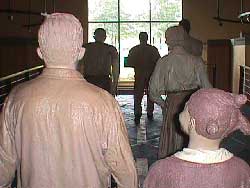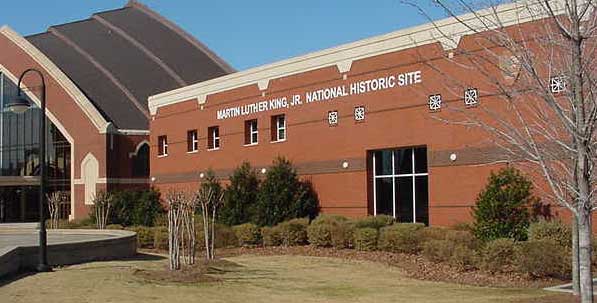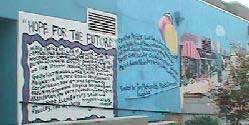All The Way to Birmingham
Middle School Literary Responses to a King Center Visit
Behold
Sarah PathammavongBehold this day that sun shines down on me,
Behold my daughter to be baptized on this sunny day,
Behold the future of my daughter to be better than mine
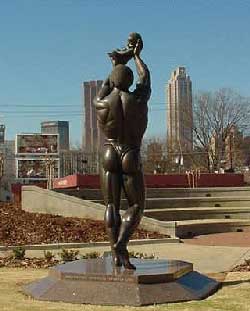
Feeling the Hate
Ashley Grove
Feeling yourself being shoved out of the doors of a "whites only" restaurant
Looking around to see crowds of angry people glaring at you with degrading eyes
Hearing cruel words coming from those who despise you
Sensing the hate, the hate that seems to be everywhere swallowing you up
Running from the men that are beating you with immense force
Protecting yourself from the bats and sticks being swung at you
Praying for the strength, the strength to keep going
Fearing what is happening, and what is yet to come
Crying tears, tears full of sorrow and painHoping it will end and that no one else will have to endure the same
VOTE
Sarah PathammavongI, a young black man marches today,
From Selma to Montgomery I march,
Though words may not always come out of my mouth,
They are said through the letters on my forehead V-O-T-E,
I march on this day in the month of March for the right to vote,
The police may bind me to silence,
But I speak my thoughts through the four letters on my forehead V-O-T-E,
They may knock me down or spray my eyes with tear gas,
I may not be able to walk or see,
But my words would be said from my forehead V-O-T-E,
Even if I shall be killed,
Those who lay me to rest will know what I died for by the letters on my forehead
V-O-T-E
Marching On
Jacqualyn Kirk
Based on the picture of the African American woman carrying a poster which says, "Justice"Battered and bruised I walk down the road,
Chanting and screaming as I go,
Freedom, freedom let there be,
The almighty lord will free me.
A warning I receive from a voice aloud,
But still I march on so bold, so proud,
Pains so sharp I feel in my back.
Because I'm not white, I am black,
A colored girl with such dignity,
After this march segregation won't be.
Through the day I face torture and pain,
But for the little I loose so much more I gain.
Hoping For a Better Future
Kristin HardyShe looks at their faces
With a heart full of pain
All she feels is the pain that they gain
She prays that her children's future
Will not be the same
The gun looks at her and she glares back
Why does she deserve this
Just because she's black
She looks at the man and then turns away
Maybe things will be different someday
All The Way to Montgomery
Sarah Baxter
As I looked up, there he stood. Dr. Martin Luther King Jr. He looked down at me and smiled. I, only being a child of eight, had received a smile for the greatest American of the time. Then he asked, "Why are you risking your life little one?" I simply replied, "For the end of our pain Dr. King. For our freedom." He smiled again and took my hand to hold it for a few seconds. I knew I was blessed and would make it all the way to Birmingham.
Later on, a reporter came to me and introduced himself as Mr. Smith. His first question was, "Why is a youngin' like you wanting to walk from here to Montgomery?" My answer to him was, "I'm making a statement to America that says, 'Although I'm young, I know what's happening and I know that it's not right.'" After about an hour, our walk began on March 7. While we were starting over the bridge we heard the policeman talking. As we got to the other side, they ordered us to go back to our homes or churches. Most of us refused while others, mostly people with children, turned and went back home. My father and mother knew how strongly I felt about this and asked me three times if I wanted to go home. Three times I refused so we continued to walk with Dr. King and the rest of our neighborhood.
The looks on some of the policeman's faces were white as could be. You could tell they didn't want to hurt us. But a few others were grinning from ear to ear. The policemen had clubs and were hitting people across all different body parts. My parents both were whacked several times. Most of the children were not harmed in any way, except for some scrapes, bruises and just a few major accidents. After a while, they used tear gas on us. That was the worst thing ever. They forced us back to Selma.
Two days later Dr. King led on a march just to the bridge. Of course I was right up there with the rest. Later, some people talked to Judge Johnson who gave us permission to go all the way to the capital without the hazard of being arrested. On Sunday march 21, 3200 of us set out for Montgomery. It was 45 miles, so we would walk 12 miles a day and then sleep in fields. It was tough after a while for me to will myself to continue walking but I just remembered what I was doing this for, for freedom. My whole body ached - from head to toe. My shoes started wearing out about the third day from walking so far. While walking down the road we would sing gospel songs to cheer ourselves up. My favorite is "Swing Low Sweet Chariot."
As we started on the fourth day, I felt a certain revival. I also had met a girl my age that had joined us the day before along with her family. As we came closer and closer to the capital I became ecstatic because I had made a statement. Maybe not to America, but certainly to myself. I'll remember that march for the rest of my life.
Author's Note I wrote this like an older person was thinking back on the Selma-to-Montgomery Freedom March. On March 7 1965 about 600 civil-rights activist started a freedom march from Selma to Montgomery, Alabama. They started out east and when they reached the Edmund Pettus Bridge, only about six blocks away from where they had started, they met up with state and local lawmen. There they were attacked with billy clubs and tear gas, and were drove back to Selma. Two days later, on March 9, Dr. King led a "symbolic" march to the bridge. Then, some civil rights leaders sought out court protection for a third, full-scale march from Selma to the capitol. Federal District Court Judge Frank M. Johnson, Jr. he allowed the demonstrators the right to march to the capitol. "The law is clear that the right to petition one's government for the redress of grievances may be exercised in large groups...," said Judge Johnson, "and these rights may be exercised by marching, even along public highways." On Sunday march 21, about 3200 demonstrators marched to Montgomery. They would walk 12 miles a day and sleep in fields at night. When they reached the capitol on Thursday march 25, they were 25,000 people stronger. In 1996 Congress created the Selma-to-Montgomery National Historic Trail in remembrance of this historic event.
Bus Stops
Cody Smith
Racial Segregation separated the country for decades. Buses were one of the things that were segregated. Whites sat in the front and blacks sat in the back. If a white person wanted to sit in the back seats due to overcrowding in the seats reserved for whites, a black person would have to move. Blacks followed this rule until 1955 when a woman named Rosa Parks refused to move out of her seat for a white person to sit down. The police were called and she was arrested. On this day, Rosa Parks started the Montgomery, Alabama bus boycott and became a guiding spirit to the civil rights movement. Many blacks refused to ride buses until the law was changed. The people brought in Martin Luther King Jr. to speak on the boycott. Blacks walked to work by foot daily through hot summer days and rainy winter days. The bus boycott made King a national personality. As Dr. King said," The problem with the buses was not between black and white, but between justice and injustice."
The MLK Museum: A reflective piece
Emily Fogle
Martin Luther King Jr. Museum is a very strong and powerful place. Right when you walk in you could see all of the information all around you. It isn't just a place where," here is the information read it." It is a place that you can really interact and understand what black people went through. When you see the pictures on the walls in kind of makes you wonder how some people can be so cruel and uncaring. Understanding and actually seeing what people had to face back then really makes you think about how you too can make a difference.
Rosa Parks and the Bus Boycott
Jeremy Tebbe
Back in the days of segregation, buses had a very different system than today. The front rows of buses were always reserved for whites. If a black set in one of the rows behind the first and a white got on, the black was asked to move so the white could sit.
One day though, a brave woman by the name Rosa Parks refused to give up her seat. She had respect for herself and her dignity. She was kicked off the bus for her "ruddiness." She encouraged a boycott against the bus companies. After just one day of boycotting, Martin Luther King was named leader of the boycott. All the blacks agreed not to use the buses no matter how far their destination was or how bad the weather was. Blacks with cars picked up walking blacks regularly.
The buses ran daily with very few passengers, and eventually faced possible bankruptcy. The protest lasted more than a year before the bus companies changed their ways and let blacks sit anywhere. The bus boycott was said by many to be one of the best movements since the Revolutionary War.
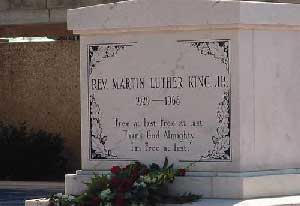
The Martin Luther King Gravesite
Reflections
Roderick Y. Battle
MLK's gravesite is a stone (rectangular) box . It sits on a brick island in water about 2 ft. deep. The pool is very long. At the beginning of the pool it has a fountain. Down the pool are step like blocks that the water goes down. The water relaxes you. As soon as I walked to the gravesite I became serious. It was a sorrowful seriousness. It seemed that it needed to be indoors. The fountain at the beginning of the pool, makes me think of his birth. Each block step reminds me of how close Dr. King was to ending segregation. Each step is a step closer to ending it. I also think that the reason his gravesite is not at the end of the pool is because he didn't live out his full life. It was a great site. I would recommend everyone to go see it.Reflection
Cori Abrain
Dr. Martin Luther King, Jr.'s gravesite was very surprising to me. I pictured it being a plaque on the ground of a little graveyard. I thought it would be a very depressing environment. Instead, it was a single, white, casket-size, block of marble concrete which, I suppose, guarded the casket. It stands on a circle of bricks, which is surrounded by water. Across from the pool of water was the internal burning flame. They say this flame is to be everlasting. It never stops burning, just like King's passion to demolish segregation. On his tomb, was written the words, "Free at last. Free at last. Thank God Almighty, I'm free at last." He is free now and has made it possible for generations after him to also be free.
The Artwork
Mary Beth White
The art,
Is the heart.
Without writing the art explains,
What the words would have proclaimed.
The emotion of happiness seems to be so clear,
But look a little closer and you will see fear.
If you could see these pictures you would say,
Who needs words anyway?
What We Keep and Create in the City
by Bonnie Webb and Sarah Robbins
Martin Luther King Center Virtual Tour a PowerPoint presentation (PowerPoint viewer required for viewing)
by Bonnie Webb's Garrett Middle School Students
The Lost World of Sid and Marty Krofft brief overview with a pdf document (Acrobat Reader needed for viewing)
by Dave Winter's Wheeler High School Students
The Varsitya PowerPoint presentation (PowerPoint viewer required for viewing)
by Sarah Breede and Roslyn Sue Smith, KSU Honors students

Content Design/Management:Traci Blanchard and Marty Lamers
Home | Curricular
Program | Thematic Content
Classroom Resources
| Community Projects |
Who We Are
© 2000-2001KCAC
No materials on this website should be copied or distributed
(except for classroom use) without written permissions from KCAC.
Questions? Comments? Contact KSU webmaster
Jim Cope.
